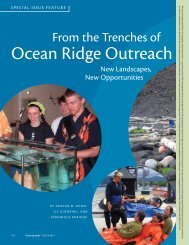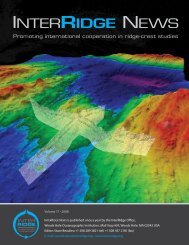Full version, low resolution, 7.5MB - InterRidge
Full version, low resolution, 7.5MB - InterRidge
Full version, low resolution, 7.5MB - InterRidge
You also want an ePaper? Increase the reach of your titles
YUMPU automatically turns print PDFs into web optimized ePapers that Google loves.
Third Decadal Plan<br />
5) How resilient are vent species/communities and how<br />
would they be affected by deep-sea mining?<br />
Although adapted to episodic extinction of sites, the ability of vent<br />
species to disperse, as well as the critical population size to al<strong>low</strong><br />
recovery from perturbation, have not been studied in most species.<br />
A wealth of information is available on some species but they do not<br />
represent all taxa, or all reproductive strategies (eg. direct vs. indirect<br />
development, large vs. small oocytes). Reproductive and dispersal<br />
strategies need to be studied in a wide variety of species. The<br />
episodic disturbance that characterises vent sites will not affect all<br />
species equally and thus the ecological balance that sustains the<br />
coexistence of species with similar niches, and with similar function<br />
in vent communities, is likely to be sensitive to both the frequency<br />
and intensity of disturbance. This is particularly important in the<br />
context of deep-sea mining because long-term and large spatial scale<br />
effects are likely with the exploitation of sulfides that host the<br />
communities.<br />
6) Could global change affect vent species, and if so on<br />
what time scales?<br />
In the context of global change, the vent ecosystems seem far from<br />
harm. However, little is known of the potential effects of warming,<br />
acidification, and increasing hypoxia of the oceans on the vent<br />
communities. Although the deep-sea water surrounding<br />
hydrothermal vents is unlikely to be affected for many years to come,<br />
it is formed at the poles and its temperature is likely to increase.<br />
Once this water is formed, it will continue on its tracks and<br />
eventually reach the vent communities. The highly dynamic character<br />
of the environment (with different degrees of acidification, hypoxia<br />
and temperature) would suggest the effects would be minimal.<br />
However, if the species already live on the edge of their capacity to<br />
cope, then a minor change could have strong detrimental effects.<br />
This is especially true of symbiotic species that are dependent on<br />
fluid emissions for their symbionts and may not be able to cope with<br />
additional challenges. This would require thorough experiments on<br />
the physiology and response of a wide variety of species. The<br />
current genetic diversity within species (adaptive polymorphism)<br />
also needs to be evaluated to predict survival and adaptability of the<br />
species. The deep-sea water parameters will need to be monitored to<br />
determine the surrounding hydrothermal vents and the deep sea in<br />
general.<br />
Implementation:<br />
a. The urgency due to the start of deep-sea mining requires an<br />
increased effort, in particular for studies of connectivity<br />
between populations, the function of the different species in<br />
the community and ecology in general.<br />
b. Connectivity studies would be facilitated with an increased<br />
effort towards transcriptome/genome sequencing. This<br />
sequencing effort will also benefit other fields of research<br />
including understanding adaptations to the vent environment<br />
and the evolution of these adaptations, as well as the history of<br />
vent phyla and communities. Understanding the evolutionary<br />
history of these species will help us predict their future.<br />
Hydrothermal vent chimney on the East Scotia Ridge imaged by<br />
the UK ChEsSo Consortium, January 2010. Mosaic image by<br />
Leigh Marsh, Jon Copley (University of Southampton) and the ISIS<br />
ROV Team (National Oceanography Centre, Southampton).<br />
c. Experimental work on live animals to determine their<br />
physiological limits remains a basic need and many species need<br />
to be studied to better understand the spectrum of adaptations.<br />
d. Studying the physiology of animals under pressure remains a<br />
technological challenge and <strong>InterRidge</strong> could help in the<br />
dissemination of such technology.<br />
e. Although some species have been very well studied, most have<br />
not. We need to increase the phylogenetic coverage of studies<br />
of physiology, tolerance, reproductive/dispersal strategies and<br />
their ecological function in the community.<br />
INTERRIDGE NEWS 13 VOL.21, 2012
















